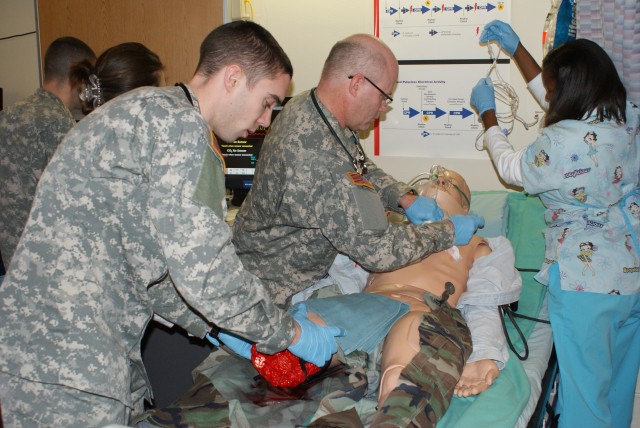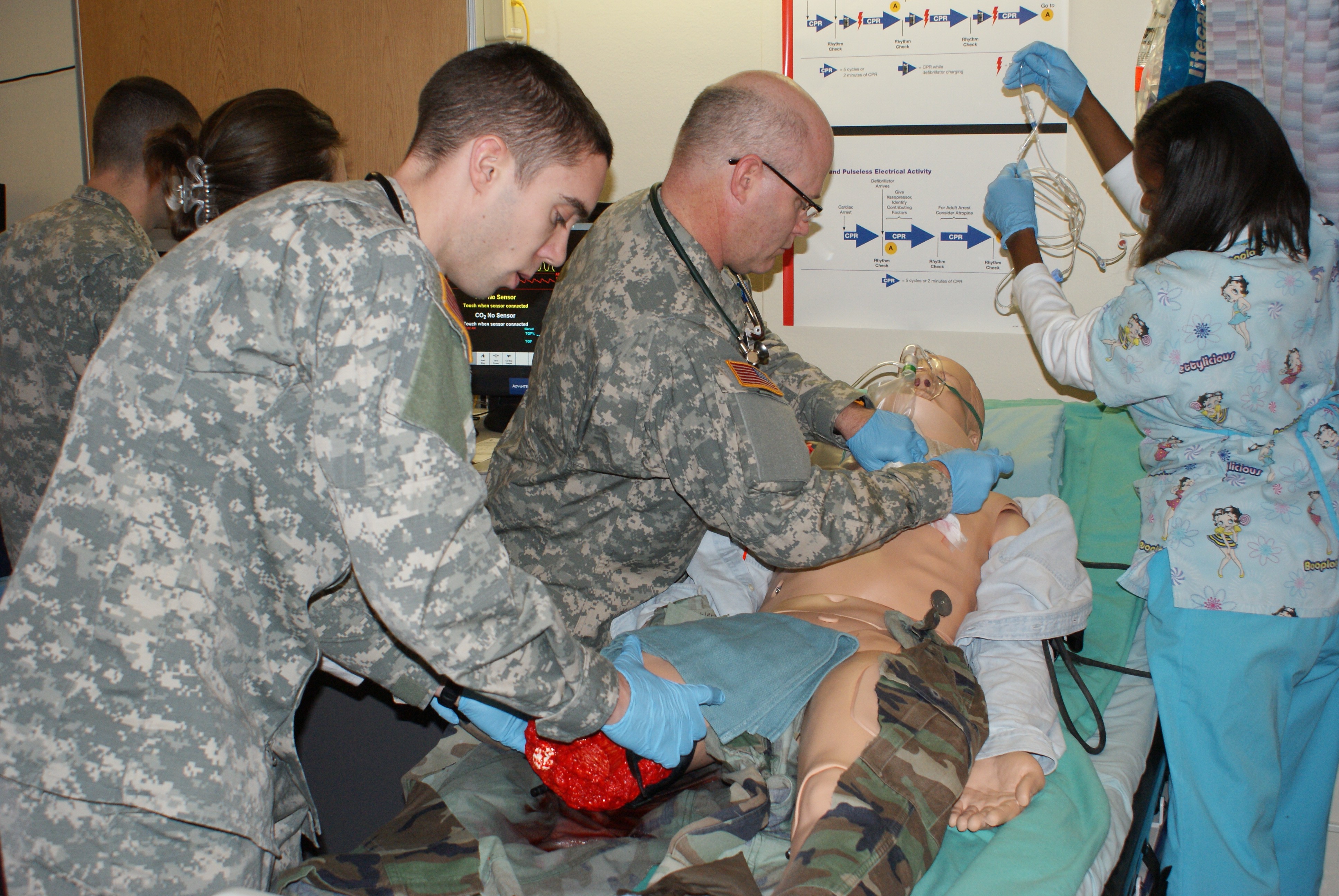
FORT HOOD, Texas - Simulated miracles occur four times a year on the third floor of the Carl R. Darnall Army Medical Center at Fort Hood, Texas.
Providers enrolled in Darnall's Family Medicine Residency Program practice complicated medical procedures on patient simulators known as the "SimMan," to enhance their education, improve their skills, and reduce medical errors.
Recently, Dr. (Maj.) Douglas Maurer, program director and simulation consultant for Darnall's Family Medicine Residency program, explained just how realistic, effective, and economical simulation could be.
"I see one, I do one on a simulator, I do one on a patient, then I teach one," says Maurer about his training method. He embedded his philosophy into the simulation program to encourage safety measures and prevent errors in patient care.
One of Maurer's responsibilities as program director is preparing role-playing and drafting scenarios of simulations for training. Scenarios can range anywhere from post-partum delivery hemorrhaging to treating an amputation.
"It's often called controlled chaos," says Dr. Charles Steiner, simulation specialist for Darnall, about the atmosphere during simulation training.
"Everyone going about their specific tasks to get that patient to return to a state of better health, staff yelling out instructions, drugs and dosages being administered-it really can get you pumped up and motivated to do the correct thing at the correct time," he says.
With approximately 30 simulator prototypes on site, doctors in the residency program can never be sure of what their next patient simulator might be experiencing, which makes the training realistic and can save lives.
Maurer explained, "The residency program has a minimum of one surprise simulation per quarter, two observed structured clinic exams, and four monthly medical mock codes for cardiac arrest in addition to performing numerous medical procedures: We are always training."
Maurer gets an opportunity to tout the success of Darnall's simulation program in June.
The Central Simulation Committee, funded by Advances in Medical Practice and the Army Medical Command, includes directors of medical education, specialty advisors, simulation directors and administrators and residency program directors from Army medical centers. "Its goal is to ensure Army providers are trained, competent, safe, and ready," said Maurer, a member of the committee.
The Central Simulation Committee is holding a workshop for the 400 directors of nationwide civilian family medicine residency programs on how to integrate medical simulation into residency education. The June 7-8 conference being held at the Overland Park Convention Center in Overland Park, Kansas, is expected to focus on a variety of procedures that can be adapted to simulation training.
"This presentation will further demonstrate to our civilian colleagues that Army Medicine continues to lead the way in residency education via the use of the latest and greatest technologies such as the NOELLE, our high fidelity obstetrics simulator," said Maurer.
With a half-a-million dollars worth of high fidelity equipment, the residency staff leads the way for other training programs in gaining expertise in their medical field. Using the most exciting and innovative health care training systems available, providers can reduce the risk of medical errors, which kills nearly 98,000 people annually.
Medical errors cost billions of dollars per year for adverse events that can be prevented. In addition to saving lives, simulation training reduces health care costs.
The simulation lab, a branch of the office of Darnall's Graduate Medical Education, uses the hands-on method to prepare doctors to respond to unexpected medical emergencies. Constant hands-on practice brings familiarity, which reduces the amount of time between diagnosis and treatment of the patient.
Darnall tests all providers performing procedures on a patient simulator using a grading system. Other doctors, peers, actor-patients, observers, and video cameras monitor and rate each provider to assurance accuracy, precision treatment, and response.
The most important reason for repetitive simulation experience is to improve skills. Performing on the computer-based, sophisticated mannequins that can breathe, respond to drugs, and talk back is probably the next best thing to real patient interaction.
To fill the gap in simulation training, Darnall was selected as one of 10 military facilities to train doctors in residency programs. Steiner, a member of the Central Simulation Committee, built Darnall's lab from scratch. After building the lab, he is now in charge of coordinating training and ensuring all personnel comply with operating procedures.
The residency program also offers a re-deployment curriculum for providers returning from theater. With long deployments, sometimes lasting up to 15 months, a provider may need to sharpen his or her skills before getting back into normal healthcare delivery.
Although, this residency simulation program is only available to commissioned officers assigned to Darnall, every major post that has deployable units must have a training facility for enlisted service members. At Fort Hood, the simulation training facility on Range Road is where enlisted members can practice procedures on patient simulators. This seven-day course demands both mental and physical strength. Unlike the Family Medicine Residency Program, medics attending this training must complete an obstacle course while at the same time attending to a wounded Soldier.

Social Sharing